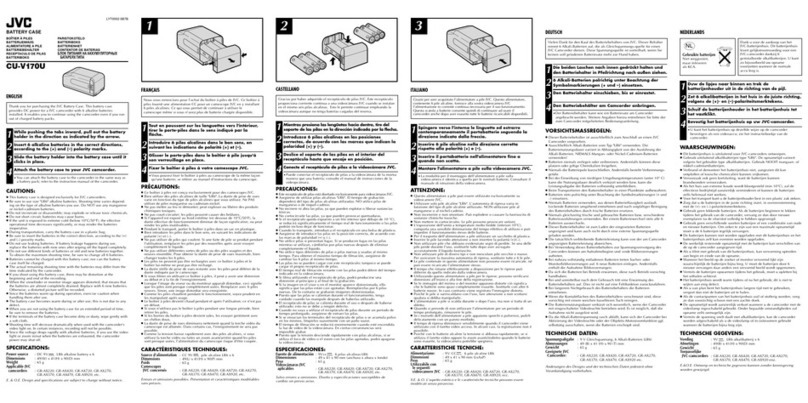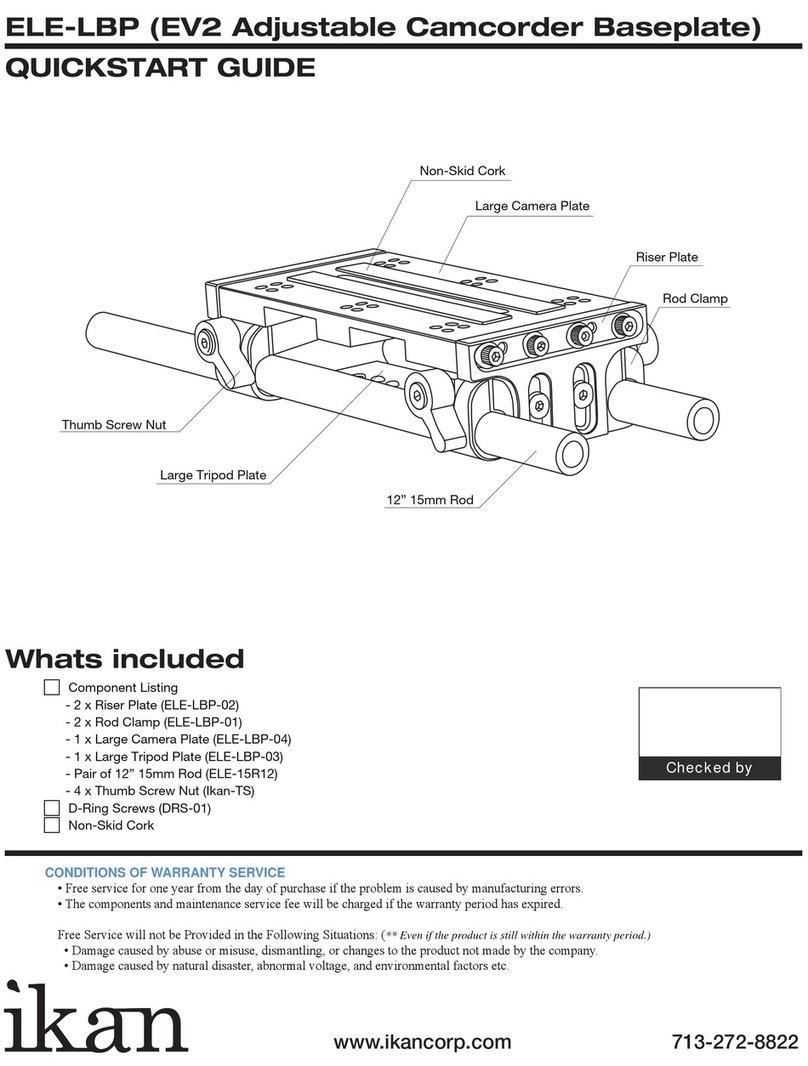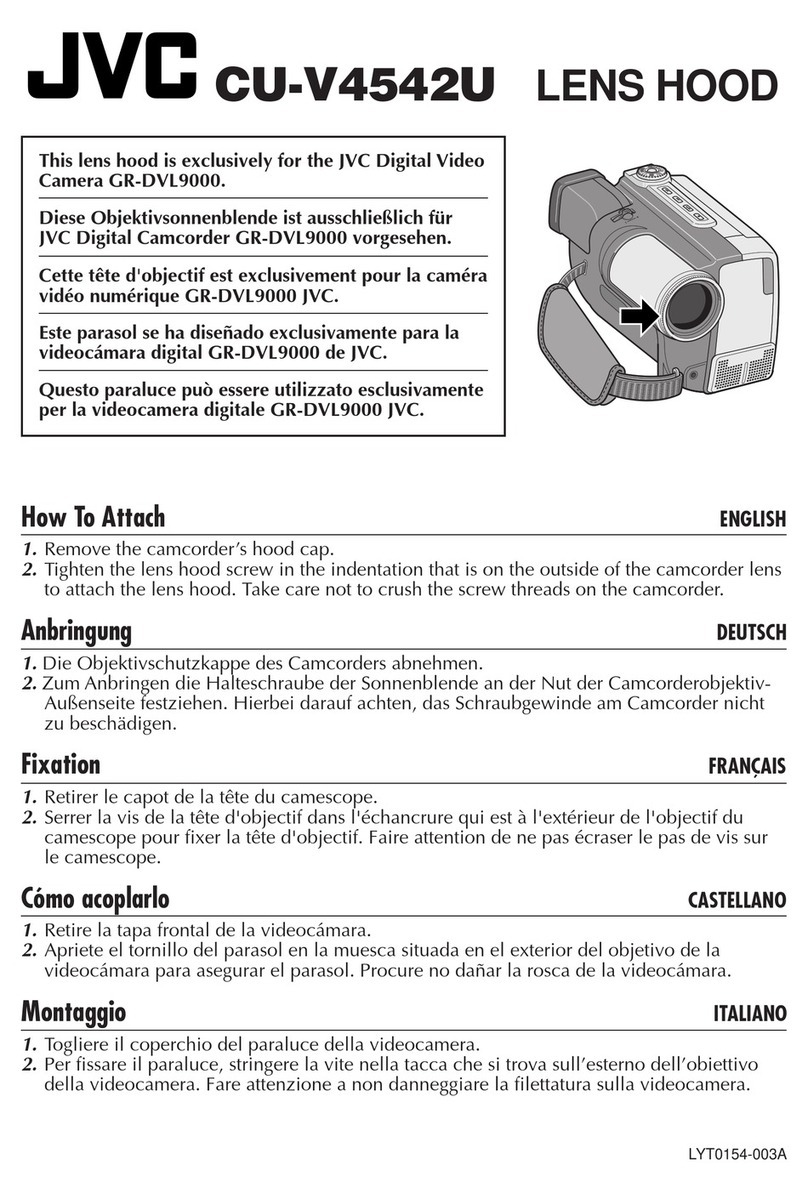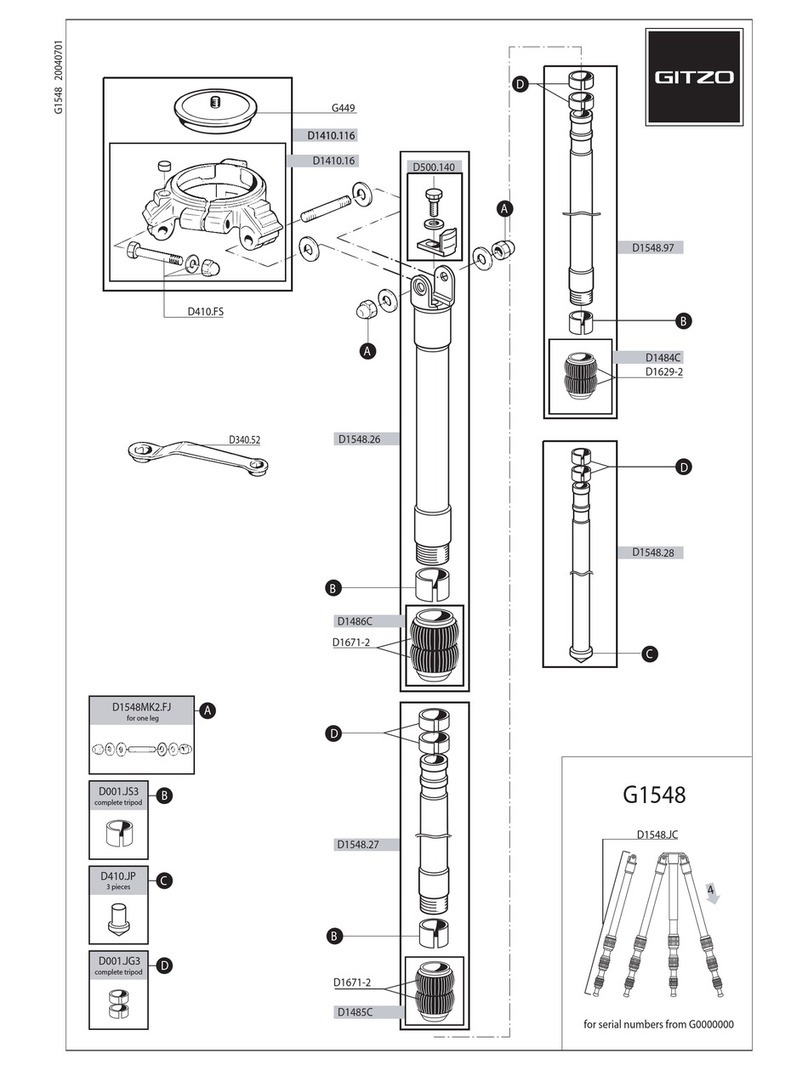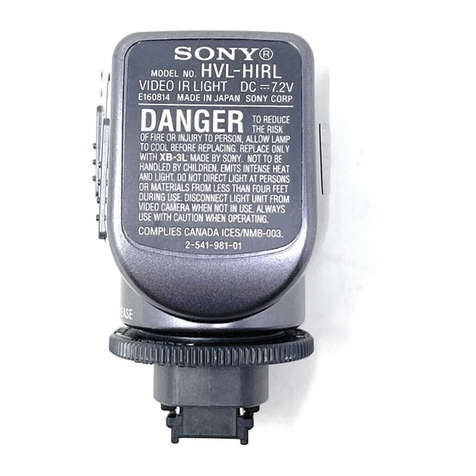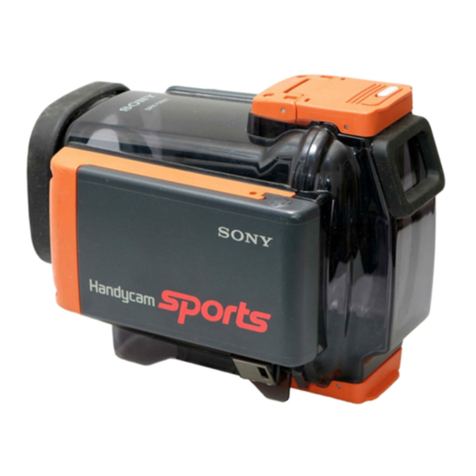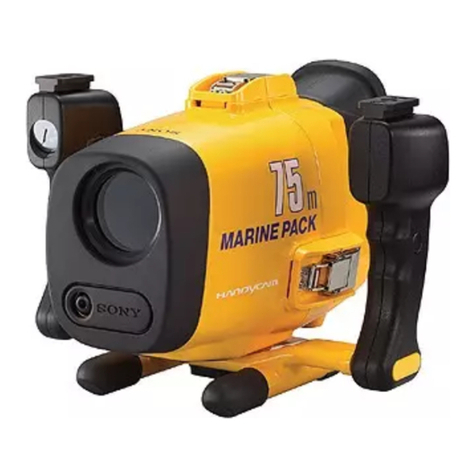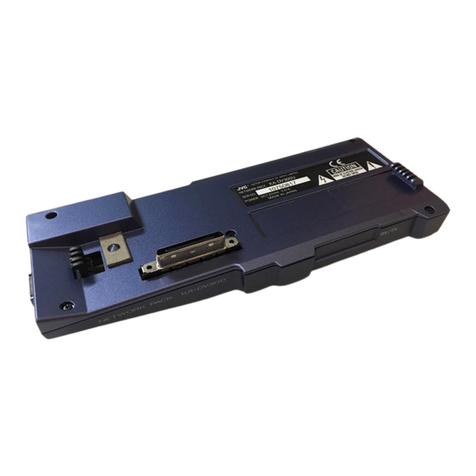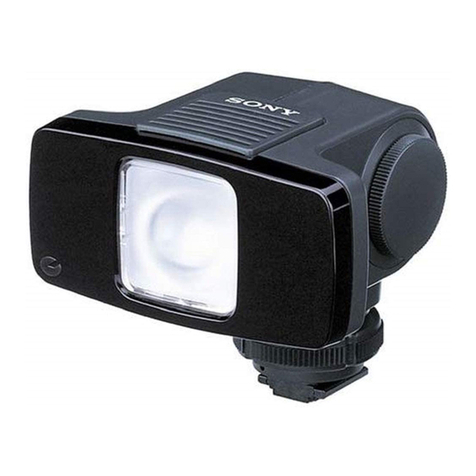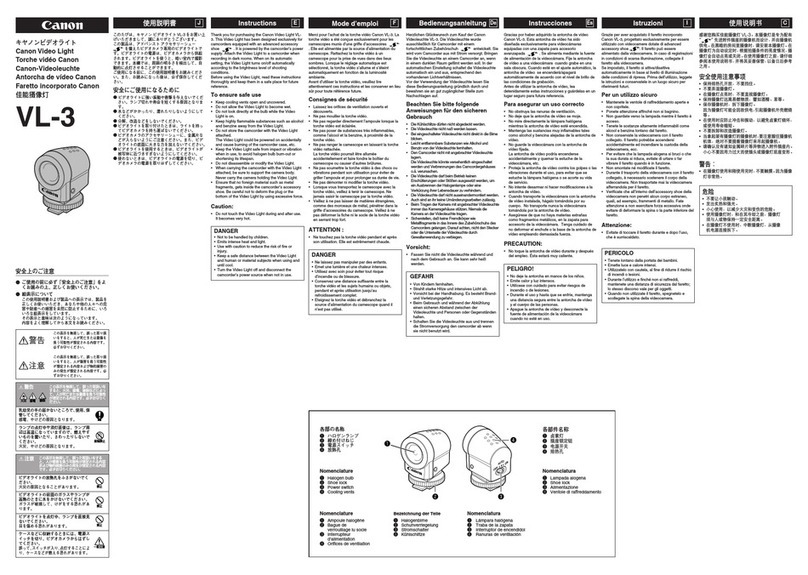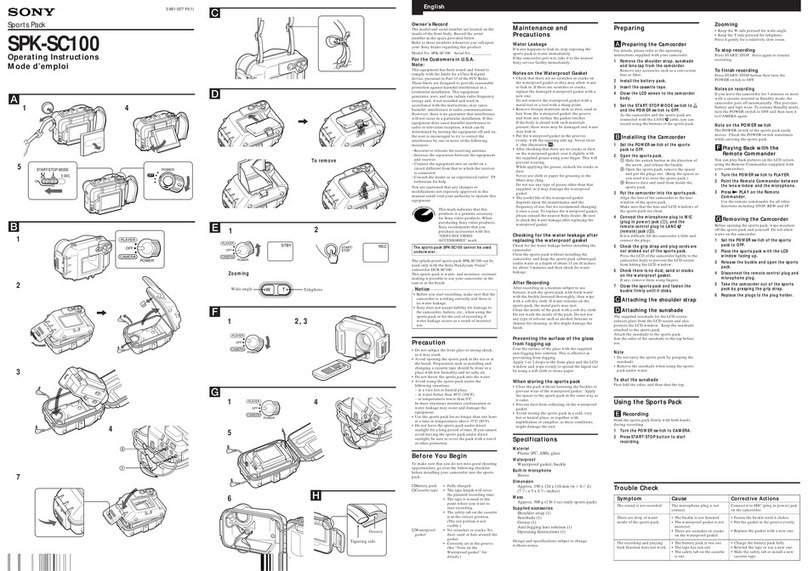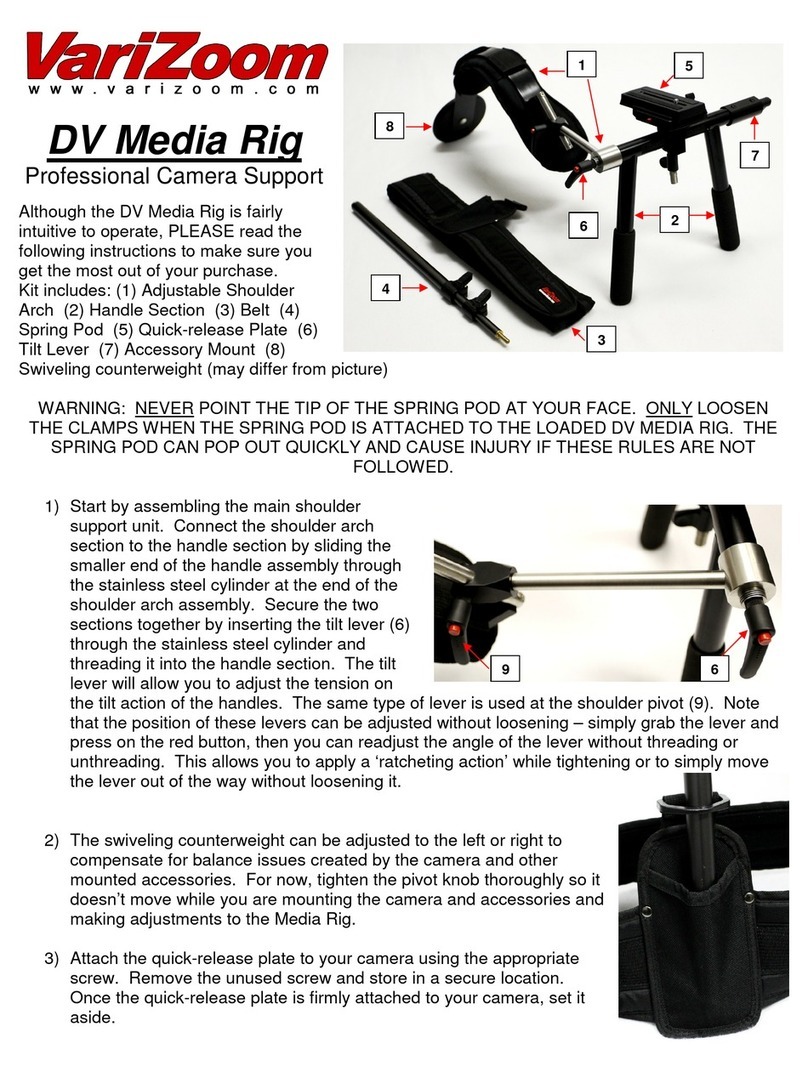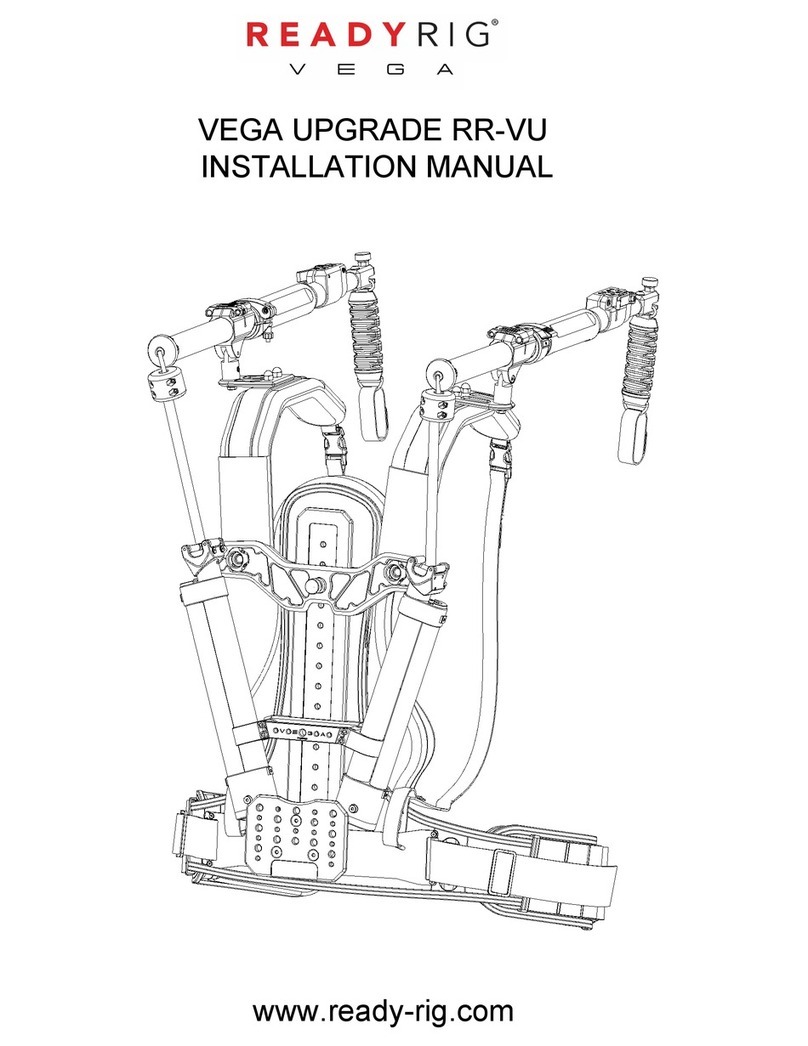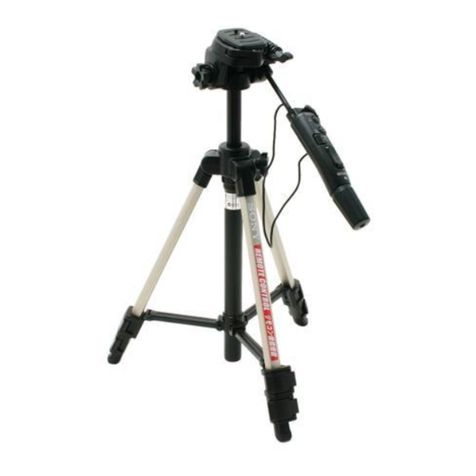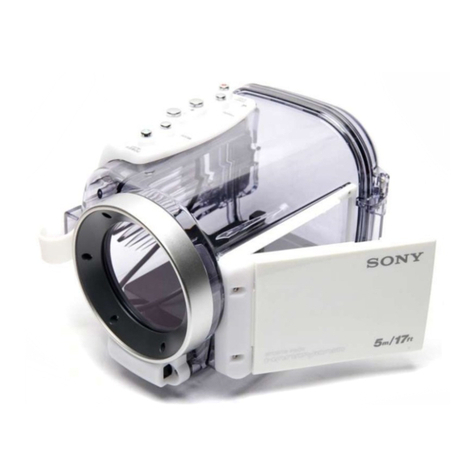Steadicam ZEPHYR User manual

Contents
Operating Manual
p/n LIT-807000

2
STEADICAM®ZEPHYR™
Operating Manual
The Tiffen Company
90 Oser Avenue
Hauppauge, New York 11788
631 273-2500
800 645-2522
631 273-2557 fax
www.steadicam.com
www.tiffen.com
Technical Support
1-818-843-4600 ext.17
Manufactured in the United States of America
© 2011 The Tiffen Company, LLC. Written by J. Holway & L. Hayball

3
Table of Contents
Overview 4
The Zephyr™Sled 6
Getting Started 8
Attaching the Camera 10
Balancing 12
The Vest 14
The Arm 16
Setting Your Threads 17
Picking Up the Sled 18
Adjusting the Lift 20
Operating a Steadicam®stabilizer will take time and effort. One key to great operating is setting up and
balancing your sled properly. Another is adjusting the vest to your body, and setting the arm to properly lift
the load.
The next steps are learning how to balance yourself with the rig, how to stand and walk, how to prevent
pendular effects as you move, and what each hand is used for.
This manual is to be used to instruct you in setting up and using your Steadicam®Zephyr™ stabilizer system.
If you have not already done so, we strongly urge you to take a 2, 3, or 6-day Steadicam®workshop for
the best possible training and start to your career as a Steadicam® operator (nd more information about
workshops at www.steadicam.com).
The Zephyr™is not a push-button magic stick that instantly creates great images. It’s a precision instrument
that responds to your touch. Although it’s not that difcult to operate, it is a skill that takes a bit of time and
effort to learn. The more effort and practice you put into operating, the better you will be, so it’s important to
develop good habits from the beginning.
Several two-hour sessions will get you started, but an operator can always be more skilled with a
Steadicam®stabilizer and also be more effective and artistic in choosing how to start, move, and stop the
camera. In the beginning, it’s helpful and more fun to have a friend work with you. Take turns practicing
and spotting for each other. Use a second video camera to record your exercises – how you stand and move
is critical for great operating.
STEADICAM®, UltraBrite®, Ultra2® and Scout™are trademarks of the Tiffen Company, LLC.
Basic Operating 22
Advanced Techniques
Dynamic Balancing 24
Low Mode 26
Accessories 28
Cases and Packing 29
The Tiffen Company, 90 Oser Avenue, Hauppauge, NY 11788 • 631-273-2500 • 1-800-645-2522 • www.tiffen.com
Tiffen Steadicam® Operations, Glendale, CA • 818-843-4600 • 1-800-593-3331 • www.steadicam.com

4
Overview
The Tiffen Company takes great
pride in producing the world’s
best stabilizers. The Zephyr™
stabilizer continues our tradition
of excellence and innovation,
lling the need for a high
performance, lightweight, and
low-cost rig.
Like all our models, the Zephyr™
stabilizer is designed to be
user-friendly, eld-serviceable,
tool-free, straightforward, and
versatile so the operator can
quickly and easily congure
the sled, arm, and vest to the
best advantage for each shot.
Change the sled length, balance,
inertia, and go to low mode in
a heartbeat. Solid, versatile,
and fast – it’s a breeze with the
Zephyr™system.
The base Zephyr™system starts with a sturdy, two section, indexed
telescoping carbon ber post coupled to a sturdy two-axis vernier
stage for quick and precise balancing. A new solid base is equipped
with independently telescoping monitor and battery rods. The Zephyr™
system comes standard with the Tango™-ready, tool-free gimbal, 16:9
SD LCD Color monitor, and a single battery mount for 12 volts—either
V-Lock or Anton Bauer (AB). 24 volts is optional.
A word about 12 and 24 volts as used in the manual: 12 and 24 volts
typically refer to the nominal voltages required by cameras and
accessories, but the voltage range accepted by the device might be 10 to
16 volts or 20 to 34 volts. Each camera or accessory has its own range
of useful voltages.
Different battery chemistries and numbers of cells typically result in
nominal battery voltages of 14.4 or 14.8 volts, or with two batteries in
series, 28.8 or 29.6 volts. The actual voltage in a battery might be from
11 to 17 volts, depending on charge and battery type. Nominal battery
voltages are always higher than the nominal required by the device, so
that when the battery is almost depleted, it still has more voltage than
that required by the device.

5
Some “12 volt” connectors on
the sled may have a regulated
(xed) output of 12 to 14.4 volts,
regardless of the voltage of the
batteries at any given moment.
Included in the base package: the
Zephyr™Iso-Elastic Stabilizer
Arm, Lightweight Zephyr™Vest,
Zephyr™Docking and Balancing
Bracket, 8 add-on Merlin™
weights, wheeled hard case with
handle, 12 volt power cable,
video cable, 2 video adaptors, the
EFP instructional DVD, and the
owner’s manual.
Options for the Zephyr™stabilizer
include a 7” high denition
monitor, 24 volts, and a compact
vest, plus batteries, chargers,
cases, stands, power and video
cables, low-mode kits, vehicle
mounts, and other professional
accessories. Visit www.tiffen.com
for more details.
The monitor and the batteries are
adjustable in and out, which, along
with the add-on Merlin™weights,
creates many choices for viewing,
balance, and inertial control.
All of the above features are
integral to the Zephyr™stabilizer
design, ready to be used when
needed.

6
Camera mounting
platform
Dovetail
lock
The Zephyr™sled
The Zephyr™Sled
Fore-aft
adjustment
knob
Stage
connectors
Post
Post clamp
Side to side
adjustment
knob
Gimbal
clamp
Add-on
weights
Add-on
weights
Clamp for sliding monitor
and battery rods

7
Gimbal
handle
Battery mount
Gimbal
Registration pin
for monitor rod
Registration pin
for battery rod
1/4-20 threads
for mounting
accessory weights
HD BNC
connector
additional LEMO
power connector

8
Getting Started
Prepare the stand and docking bracket
Set up the stand and docking bracket:
Prepare the sled for the camera
• Set up your stand at about chest
height.
• Use one or more sandbags to
stabilize the stand.
• Put the docking bracket on the
stand and tighten the docking
bracket locking knob.
• Push the button at the end of the
aircraft pin and pull the aircraft pin
out of the yoke.
Adjust the monitor position:
• Position the monitor and battery
sliding rods as shown. If required,
you may need to temporarily
remove the locating pin for
the monitor rod to achieve this
extension.
• Add the accessory weights to the
rods as shown. For starters, use
1 middle and 1 starter weight on
each tube.
• Tilt the monitor to about 45 degrees.
Adjust the gimbal position:
• Slide the gimbal close to the top of
the center post, but always leave
enough space between the gimbal
and the stage to accommodate the
docking yoke (about 1in/25mm).
.

9
Adjust the battery position and
attach the batteries:
• Attach the battery onto the battery
mount. Be sure the safety catch is
engaged.
Dock the sled in the docking
bracket:
• Hold the sled upright, with the
monitor (front) to the left. Place the
center post into the bracket so the
bottom of the stage rests on the
yoke.
• Push the aircraft pin back through
the yoke, securing the post in the
bracket.
dovetail
lock
fore-aft
adjustment
knob
side to side
adjustment
knob
Remove the dovetail from the
stage and set aside:
• Loosen the dovetail locking knob
until the dovetail can be tilted out
sideways.
• Safety stops on the dovetail keep
the dovetail from sliding off the
stage when the dovetail locking
knob is loose.
• The stops also prevent the dovetail
from being inserted into the front
or rear of the stage. Therefore, do
not attempt to slide the dovetail into
place from the front or back.
Back of stage:
• Camera power connector. 3 pin
LEMO: EGG.0B.303.
• Standard denition (PAL/NTSC)
composite video in. BNC
V-lock battery
AB battery
Front of stage:
• HD BNC
• Two expansion ports for future
options and accessories.
• Additional power connector.
3-pin LEMO: EGG.0B.303.

10
Attaching the
Camera
Attaching the camera to the sled
We attach the camera to the sled via a dovetail plate. With the Zephyr™stabilizer,
this plate has safety stops on the ends, and several holes for mounting screws. We
want to attach the dovetail to the camera so that we have the widest possible range of
adjustment, both fore-aft and side to side.
We start this process by nding the
camera’s center of gravity (c.g.) or
balance point, then properly position the
dovetail plate relative to the camera’s c.g.
Finding the camera’s c.g.:
• If you like, remove the battery from
your camera if it has an auxiliary
power input, either 12 or 24 volts.
With a very heavy camera (15+
pounds/6.8kg or so), this is a good
idea, but it’s not necessary or
advisable with a very light camera.
• Attach all accessories, matte boxes,
obie lights, etc. and load the tape
or lm. If the camera has a quick-
release plate (tripod adaptor), leave
it on the camera.
• Balance the camera fore-aft on a
rod or pencil (as shown) and mark
the balance point with a piece of
tape.
• Repeat for side to side.
Attaching the dovetail plate:
• Examine the dovetail. Turn it over to
locate the three rows of large and
small slots, and the stops.
• Remove the screws that are stored
at the front of the dovetail.
• Place the dovetail against the
bottom of the camera (or quick
release plate) and move the dovetail
fore-aft until the second slot from
the rear is over the camera’s c.g.
This position is not intuitive, so
pay close attention to this detail.
• Now move the dovetail as little as
possible until one or more screw
holes are accessible. Choose
holes as far apart as possible for
maximum stability.
• Insert the screws and tighten with a
screwdriver.
Finding the camera’s side to
side center of gravity.
Finding the camera’s fore-aft
center of gravity.

11
Mounting the camera on the sled:
• Place the camera above the camera mounting platform. Be sure the locking
knob is loose. Angle the right edge of the dovetail into the holder. Be sure to
keep everything parallel. Lower the left side into the holder.
• If the camera won’t drop fully into place, be sure the right side of the dovetail
is fully inserted, all is parallel, and the locking mechanism is out of the way.
It’s a close t.
Connect the power and video
cables and test that everything
works:
• Connect the BNC to BNC
video cable (use the BNC to
RCA adapter if necessary)
from the camera to the video
input on the back of the stage.
If necessary, choose the
camera’s video output that
allows you to watch playback
as well as “live” video.
• If necessary, connect the
power cable by plugging the
three-pin Lemo into the Power
output on the back of the stage
and the other end into the
appropriate DC power input on
your camera. Several power
cables are available for various
cameras and voltages. See the
accessories page for the power
cable details.
• Secure the cables with cable
ties, Velcro®, or gaffer tape.
Leave enough slack for
adjustment of the stage.
• Power up the monitor and
camera to make sure you have
a picture. If you do not, try
adjusting the brightness and
contrast controls; check the
cables, battery voltage, etc.
• Turn off the camera and
monitor.
Now proceed to static balance
the sled.
• Camera power connector.
3 pin LEMO: EGG.0B.303.
• Standard denition (PAL/NTSC)
composite video in. BNC
• After the dovetail drops into place, slide the camera until the fore-aft c.g.
mark is about .5in (12mm) behind the centerline of the telescoping posts.
The post is 1.1in (28mm) in diameter, so you can use the back of the post
as a guide for placing the camera c.g.
• Tighten the locking knob to fully lock the camera into place. You are now
ready to static balance the sled.

12
Balancing
Balancing the sled
The Steadicam®Zephyr™stabilizing system works, in part, by the careful balancing of
components (camera, monitor, accessories, and battery). We always balance the sled
to help us get the shot, so that the operator does the least amount of work to aim the
camera. There are several components of balance. The rst one to work on is “static”
balance, where we balance the sled in all three axes (top-to-bottom, side to side, and
fore-aft), so that the sled hangs upright and is not too bottom heavy.
To adjust the balance, we need to put the sled on the docking bracket
balancing stud where it can hang freely from the gimbal
• Pull the aircraft pin and remove the
sled and camera from the docking
bracket.
• Release the top clamp knob and
slide and extend the docking
bracket. Tighten the locking knob.
• Place the gimbal’s mounting hole
on the balancing stud.
Top to bottom balance
Let’s start with top-to-bottom balance, as
it is one of the least understood aspects of
balance.
It’s best if the sled is slightly bottom
heavy. Clearly, if it is top heavy, it will
tip over. If it is too bottom heavy, it will
hang upright (a good thing) but be hard to
tilt and very hard to control as you move
around (not good at all!).
Note: Before letting go of
the sled, be certain that
it will hang more or less
upright. If the sled wants
to hang upside down, the
camera weight is beyond
the weight specications of
the Steadicam®Zephyr™.
So immediately, you should understand
that top-to-bottom balance is a
compromise between competing desires.
If it is just slightly bottom heavy, it can
be balanced to hang at a particular angle
and easier to control.
How do we get the right top-to-bottom
balance?
When balancing a
heavier camera, you
may have to extend
the post. While holding
the bottom of the sled,
release the post clamp
and lengthen the post.
Close the clamp.
12
If the sled is neutrally balanced (neither
top nor bottom heavy) it’s impossible to
balance the sled fore-aft or side to side,
and the operator must do all the aiming of
the sled – not good either.
Note: changing the
length also changes
the range of lens
heights. This can
be a useful tool with
any weight camera.

13
• With one hand rmly holding the
camera or the center post, open
the gimbal clamp. Remember to
always keep the post horizontal
when the gimbal clamp is
loosened!
• Grasp the center post and carefully
slide the post in the gimbal. Use
your thumb to push against the
gimbal. Find the place where the
sled is balanced on the gimbal
like a seesaw on a fulcrum. Then
slide the post through the gimbal
about 1/2” (12mm) towards the
battery. This will place the sled’s
c.g. 1/2” (12mm) below the gimbal
yoke bearings, and the sled will be
slightly bottom heavy.
• Close the gimbal clamp.
WARNING: If you open
the gimbal clamp when
the center post is
vertical, the whole sled
will drop rapidly and
damage your sled.
We will ne-tune top to bottom balance
after we get close to fore-aft and side to
side balance. We may need to ne-tune
the balance in one axis after we balance
in another axis. The object is to get as
close as possible to the best balance for
the shot.
Look at the sled from the side. If the sled is tipped up or down:
• Hold the center post vertical.
• Move the camera forward or
backward by turning the fore-aft
knob until the camera is level. You
can use a bubble level to help you
nd vertical.
Now we are ready to ne-tune the top-to-bottom balance by using the
“drop time” test
• Make sure the dovetail locking knob is tight.
• It’s good to have an assistant hold the stand.
• Rotate the sled to horizontal.
• Let go of the center post.
• Count how many seconds it takes the center post to fall through vertical.
If the rig has a drop time of less than two seconds it is too bottom heavy. You need to
move the sled’s c.g. upwards, closer to the gimbal. If the drop time is more than three
seconds, move the sled’s c.g. lower, further from the gimbal:
• With the rig horizontal, open the clamp and slide the centerpost through the
gimbal about 1/8” (3mm) in the proper direction.
• Close the gimbal clamp.
• Re-do the drop test. Keep making small adjustments until the sled has a 2
to 3 second drop time.
• Recheck the fore-aft and side to side balance by looking at the sled. Trim
with the fore-aft and side to side knobs as necessary.
Note: A drop time of 1 to 4 seconds might be best for a
particular shot. You will eventually determine what works
best for you for average shooting, and what works best
for you for each shot. But let’s start with a 2 to 3 second
drop time.
fore-aft
adjustment
knob
side to side
adjustment
knob
Fine tune the side to side balance:
• Look at the sled from the front or rear.
Adjust the side to side knob on the stage
until the center post is vertical. Again, you
can use a bubble level to help you nd
vertical.
balance point of
the gimbal
First we position the gimbal, which acts
as a pivot point, just a bit above the
center of gravity on the center post, and
here’s how we do that:
• Rotate the center post to horizontal.
Hold it securely.

14
The Vest
The vest
Shoulder
pad
Chest pad
Adjustable
spar
Adjustable
velcro®straps
Chest
connectors
Shoulder
connector
Socket block
Hip
pad
Socket block
height adjustment
Chest plate
release pin
Note: Shorten or extend the shoulder
straps so that the clip is high on your
shoulders when the chest straps are
horizontal.
Also be sure that the shoulder straps
are evenly extended and at the same
angle to the Velcro®.
Use an allen key to
unlock and adjust the
angle of the shoulder
connector

15
Please read the vest instructions
completely before you try to put the vest
on. It is very helpful to have a friend help
you the rst time you put on the vest.
Otherwise use a full-length mirror.
Open the vest
• Loosen both chest straps.
• Release the hip straps on the left
side.
• Open the chest buckle on the left
side.
• Open the shoulder buckle on the
left side.
• Slip the vest on.
• Close the shoulder buckle.
• Close the chest buckle.
• Center the chest plate on your
chest.
• Tighten the chest straps evenly and
secure the loose, Velcro® ends.
• Push down on the chest plate to
seat the shoulder pads on your
shoulders.
Note: A few operators have
body shapes or sizes that
are out of the general range
of adjustments. You may
nd you have to add or
remove padding, shorten
or extend straps, etc. to
make the vest t perfectly.
Pay close attention to the good
t of the vest in the photo
above. It’s very important how
the shoulder pads contact the
shoulders and the shoulder
connectors are not too high (a
common mistake).
Putting on the vest
• Pull out the chest plate release pin
and adjust the center spar up or
down so the hip pad sits centered
on your hips. Replace the chest
plate release pin in the nearest
hole.
• Be sure the Velcro® straps are
horizontal on the hip pads, and
tighten the hip straps completely
and evenly.
• Close the buckles at the chest and
hips.
• The vest should be very snug,
but not uncomfortable. Adjust the
straps as necessary.
Removing the vest
The vest should be unbuckled on the left
side only, from bottom to top:
• Undo the hip strap rst.
• Undo the chest buckle.
• Undo the shoulder buckle and
slip out of the vest. When you
put it back on, you will not need
to readjust the chest plate or the
chest straps.

16
The arm
Steel
springs Lift adjustment
knob
The Arm Arm post
Double action
hinge
Rod ends
Socket
Socket quick
release pin
Upper arm section
Lift
adjustment
knob
Forearm section
The arm socket is inserted into
the socket block on the vest.
Mounting the arm to the vest
The arm mates with the vest via an
adjustable socket in the arm and a
female socket block on the vest. The two
adjustment screws in the socket block on
the vest and two “rod ends” in the mating
section of the arm determine the lift angle
of the arm. These two adjustments are your
“threads,” and they are specic to your
body size and shape. Setting your threads
correctly is critical for good operating.
Some combination of adjustment of
these screws – and your physique and
posture – will make the arm lift straight
up when carrying the sled. The angles
of adjustment are not directly “in-out”
and “side to side”, but rotated about
30° clockwise (relative to the operator).
We will suggest approximate threads to
start, but the only real way to test your
threads is to pick up the sled and see what
happens. You can’t set your threads fully
without picking up the rig.

17
in-and-out: count
threads here
Goofy foot
If you want to operate “goofy-foot,” – with the sled on the right side – you will
need to reverse the socket block before starting.
Determining your threads is part of basic operating technique
For almost all operators, regardless of
body type, the typical adjustment for the
“side to side” screws (the rod ends in
the arm) is 1.5 to 2 turns out on the top
screw and ALWAYS all the way in on the
bottom screw.
Use the rollers when the arm is not
under load. If you are ying the sled,
lift it up with your left hand to take the
weight off the screws before adjusting
them. The two side to side screws work
independently of one another. Do not
tighten the lower screw, but be sure it is
all the way in, and then back it out 1/8th
of a turn.
The “in-out” screws work in tandem,
and the adjustment varies greatly by the
operator’s body type.
Adjusting your threads
• If you have big pectorals and a
at stomach, the top screw is
almost all the way in. If you’ve
been eating well and exercising
less, the top screw will be
further out.
• Always dial in the top screw rst
to your setting, then turn in the
bottom screw until it just snugs
up against the tting. There is
no need to tighten the bottom
screw very hard.
• Always keep a hand on the
free end of the arm, otherwise
it might swing around and hit
something, someone, or you in
the face.
• With both pairs of screws
properly adjusted, the sled
will oat in all positions with
the operator standing in good
posture with a vertical torso. If
the threads are not adjusted
well, the sled will tend to y or
fall away from you.
• On the vest, remove the breast plate: Loosening the lock; pull the locator
pin; and slide the plate completely off. Then remove the socket block in
the same manner. Flip the block 180° and re-attach (above).
• On the arm, pull the aircraft pin to separate the socket from the arm. Turn
it over and re-attach.
• Set the top screw about two turns out, and the bottom screw all the way in.
side to side: 2
turns out on top

18
Picking Up the
Sled
Undocking, setting your threads, and docking the sled
With the vest on and the arm attached to the vest, undock the rig:
• Face the sled and bow at the waist.
Do not bend your knees. It is
helpful to have a friend spotting you
the rst time you do it.
• Align the gimbal mounting hole to
the arm post and slip the arm post
completely into the hole. It’s easiest
to align the parts if the gimbal
handle is positioned behind the rig
(i.e., not to the side, aimed at you).
• Use your right hand to hold the arm
and gimbal together (frame 4).
• Place your left hand on the center
post just below the gimbal to
control the sled. Do not touch the
camera (frame 4).
• Step forward and stand up straight.
You are now ying the sled, but still
locked in the dock.
• Pull the aircraft pin out of the
docking yoke (frame 6).
• Step back from the stand to remove
the sled from the docking bracket.
• Take a deep breath. Relax.
• Move the sled to a position about
45º off your left hip as shown.
• Aim the sled slightly across your
body (frame 9).
12 3
Picking up the sled

19
• If the sled wants to move away from
you, loosen the bottom in-out screw
and dial in the upper screw a few
turns. Snug up the lower screw and
re-test.
• If the sled wants to move towards
you, loosen the upper in-out screw
a few turns, snug up the lower
screw, and re-test.
• Do not get too fussy with your
threads at this point, as much of
the trick is learning to properly
stand and move, rather than
adjusting your threads.
• Take a few steps and experiment
with the feel of it all. Try panning
and tilting. Before you get tired,
dock the sled.
Test your threads
• Stand as upright as possible, in
good posture, with the rig off your
left hip. Don’t be stiff or tense.
Do not ever let go of the sled
completely, but let it move a little.
• If it tends to stay in place, try
moving it further out in front of you.
Lean back a little as you feel the
vest pushing against your stomach
and pulling your torso forward. The
trick is to lean a little bit away from
the rig – more if it’s further from
you, less as it’s closer to you – so
that the sled wants to stay in place
or oat next to you.
• If the sled wants to move off in one
direction rather dramatically and
you can’t lean forward or back
easily to correct it, you need to
adjust your threads. Typically it’s a
matter of the “in-out” screws rather
than the side to side screws.
Holding the rig might feel awkward at rst. Don’t worry
– you will gain control and endurance rapidly as you
practice. The rst time is typically the most annoying,
because there are so many adjustments to make before
it all falls into place and “magically” works with you. It
may be that you will want to adjust the lift capacity of the
arm (see pages 20-21) before ne-tuning your threads.
Eventually you must adjust them both.
Practice replacing the sled in
the docking bracket
• Step up next to the docking stand
with the camera aimed to the left.
• Insert the center post in the bracket
and rest the stage on the docking
yoke.
• Insert the aircraft pin back in the
docking yoke to secure the sled.
• Bow from the waist and step back.
• Move your left hand to the gimbal
handle, and your right hand to the
arm.
• Hold up the gimbal handle and
let the arm post slide out of the
gimbal mounting hole. Don’t force
it or bend your knees; just nd the
correct angle so that the arm post
slips out of the gimbal.
• Always keep a hand on the free end
of the arm, otherwise it might swing
around and hit something.
• Rest. Stretch.
• When you don’t have time to dock
and undock, you can relieve some
muscle tension by holding the rig
close to your body on either side or
clasping the camera close to your
chest.
4 5 6 7 8 9

20
Adjusting the Lift Adjusting the arm
• With the vest on, attach the arm
and undock the rig as before.
• Stand with the sled off your left hip,
with the lens slightly crossing your
body.
• Move the arm to the middle of its
boom range and let it rise or fall.
Do not completely let go of the
sled.
Setting the lift capacity of the arm
Now it’s time to adjust the arm for the weight of your camera.
Important: The lift
adjustment knobs can
only be turned when the
arm segments are slightly
above horizontal. They
cannot be turned when
the arm is unloaded, i.e.,
when not lifting the sled,
nor if the arm sections
are boomed too far up or
down. Do not force the lift
knobs. At the right angle,
they turn very easily.
• Ideally, each section of the arm
should come to rest slightly above
horizontal, about 5º to 10º.
• Adjust the arm section nearest the
sled rst (the forearm section).
• If the arm oats at too high an
angle, pull the sled down with your
left hand until the forearm section
is about 5º above horizontal.
Turn the weight adjustment knob
counterclockwise until the forearm
wants to oat at this angle.
• If the arm oats at too low an angle,
pull the sled up with your left hand
until the forearm section is about 5º
above horizontal.
• Repeat the process with the upper
arm section, but this time try to get
the upper arm to follow the forearm
as you boom up and down.
• Turn the weight adjustment knob
clockwise until the forearm wants to
oat slightly above horizontal.
• Keep making small adjustments
until the forearm settles at a 5º
angle up from horizontal.
• Remember, the weight adjustment
knob turns freely when the arm
section is slightly above horizontal.
Never force it or use a tool to adjust
the arm lift.
Table of contents
